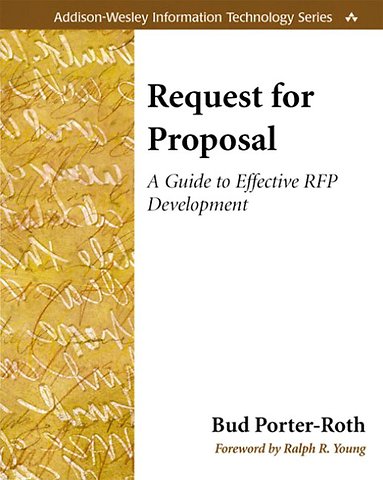Request for Proposal
A Guide to Effective RFP Development
Paperback Engels 2002 9780201775754Samenvatting
Praise for Request for Proposal
“Bud Porter-Roth is an expert in the field of preparing RFPs, and we could not have successfully completed our project without his skill and knowledge. This book is a clear guide to an otherwise complex and difficult process. If you can’t hire Bud Porter-Roth to write your RFP, then you should buy this book.” — Lori Deibel, Manager, Library Services
“This book is priceless. It is a must for a novice writing an RFP.” — Doris Lopez, Senior Systems Engineer, O-Cedar Brands, Inc.
“This book brings a structure to a process that is too often unstructured. There have been no standards (outside of government) that I know of that apply to RFP preparation. I also believe that vendors (sellers) would welcome a more uniform and consistent style of RFP.” — Frank Tillman, API Systems Group
“This book provides overall coverage on a subject that deserves some real guidance. I like very much the sentiment concerning the RFP as the basis for a team and the idea that the RFP is the beginning, not the end. His emphasis on the need for clarity in the RFP and for measurable requirements needs to be heard and understood by many within the target audience. He takes an excellent position on ‘Why Write an RFP’.” — Patricia Oberndorf, SEI
“This book is well written and insightful. It provides good information on what makes a good requirement, how proposals are evaluated, and what precautions to take to prevent early elimination.” — Linda Fernandez
“Just a note to tell you thank you for providing some tips on how to structure an RFP. I work for a small company who does not have a specific template for this purpose and found your guidance a very useful starting point.” — Dan Salo
Despite its importance as an initial step in the development of major technical projects, the Request for Proposal (RFP) process rarely receives the professional attention it deserves. Used by government agencies and by private corporations to solicit proposals from contractors and vendors, the RFP document is the foundation for a successful project. A clearly written and properly organized RFP clarifies technical goals, communicates administrative and financial expectations, and sets the tone for good communication and a trusting and productive relationship between customer and contractor.
This experience-based handbook offers a systematic, comprehensive, and professional approach to writing RFPs. It guides you step-by-step—from initial planning to selecting the winning proposal—through the RFP process, demonstrating the most effective ways of structuring the document and expressing technical, administrative, and financial requirements. Request for Proposal: A Guide to Effective RFP Development focuses on the major goals of the RFP process—to elicit high-quality responses from potential contractors and promote effective communication between the client and the chosen vendor.
You will be able to: Plan and organize the RFP effort Outline each RFP section Develop, write, and review all requirements, including those that are administrative, technical, and managerial Set realistic pricing requirements Pre-screen a vendor list to select appropriate vendors Set up objective evaluation criteria for selecting the best solution Prepare for post-RFP activities such as site visits, reference checks, and implementation activities
In addition, this book includes several templates you can adapt for your own organization’s RFP efforts. Request for Proposal gives numerous examples of both effective and poorly-written RFP requirements that illustrate the author’s points and provide solid advice to help you avoid common pitfalls and implement best practices.
For anyone with the responsibility of writing RFPs or responding to them, this book is are source you will want to keep close at hand.
Specificaties
Lezersrecensies
Inhoudsopgave
Rubrieken
- advisering
- algemeen management
- coaching en trainen
- communicatie en media
- economie
- financieel management
- inkoop en logistiek
- internet en social media
- it-management / ict
- juridisch
- leiderschap
- marketing
- mens en maatschappij
- non-profit
- ondernemen
- organisatiekunde
- personal finance
- personeelsmanagement
- persoonlijke effectiviteit
- projectmanagement
- psychologie
- reclame en verkoop
- strategisch management
- verandermanagement
- werk en loopbaan
